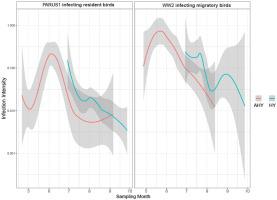International Journal for Parasitology ( IF 3.7 ) Pub Date : 2020-06-26 , DOI: 10.1016/j.ijpara.2020.05.006 Xi Huang 1 , Jane Jönsson 2 , Staffan Bensch 2

|
Infection patterns of avian haemosporidians result from the evolution of their associations with hosts, and can be shaped by multiple biotic factors. However, at the level of parasite species, few studies have investigated the details of the temporal dynamics of infection patterns in wild bird communities. We hereby studied a wild bird community in southern Sweden to investigate two generalist parasites (cyt b lineages PARUS1 and WW2) of the morphological species Haemoproteus majoris in their main host species (tits and warblers, respectively) to look for seasonal (spring to autumn) and age class related variation in infection patterns. For both lineages, we detected a similar temporal pattern in prevalence and infection intensity, with peak levels during the main nesting season in adults and a few weeks later in juveniles. Infections in juveniles were detected as soon as they started to be caught by mist nets, implying that they became infected when still in the nest or during the first weeks post-fledging. The initially high intensities in juveniles were followed by a significant decrease during the hatching year, emphasising the importance of studying haemosporidian infections in nestlings and fledglings. Both prevalence and infection intensity in adults increased from spring to early summer, either due to spring relapses or new infections. Both prevalence and infection intensity declined in adults at the time when independent juveniles of the respective species started to appear, suggesting that the rate of parasite withdrawal from blood exceeded the rates of new infections gained and relapses of previous infections. Prevalence in both juveniles and adults approached zero towards the end of the summer.
中文翻译:

野生鸟类血孢子虫的持久性:一个案例研究,说明与宿主生命阶段相关的季节性感染模式。
禽血孢子虫的感染模式源于它们与宿主关联的演变,并可受多种生物因素的影响。然而,在寄生虫物种的水平上,很少有研究调查野生鸟类群落感染模式的时间动态细节。我们在此研究了瑞典南部的一个野生鸟类群落,以调查形态学物种Haemoproteus majoris 的两种通才寄生虫(细胞色素 b谱系 PARUS1 和 WW2)在它们的主要宿主物种(分别为山雀和莺)中寻找季节性(春季到秋季)和年龄等级相关的感染模式变化。对于这两个谱系,我们在流行率和感染强度方面检测到相似的时间模式,在成虫的主要筑巢季节和几周后的幼虫达到峰值。幼鱼一开始被雾网捕获就被检测到感染,这意味着它们在巢中或在孵化后的最初几周内被感染。幼鸟最初的高强度随后在孵化年显着下降,这强调了研究雏鸟和雏鸟血孢子虫感染的重要性。从春季到初夏,成人的流行率和感染强度均有所增加,由于春季复发或新感染。当各个物种的独立幼虫开始出现时,成虫的流行率和感染强度都下降,这表明寄生虫从血液中撤出的速度超过了新感染和先前感染复发的速度。到夏末,青少年和成人的患病率都接近于零。











































 京公网安备 11010802027423号
京公网安备 11010802027423号